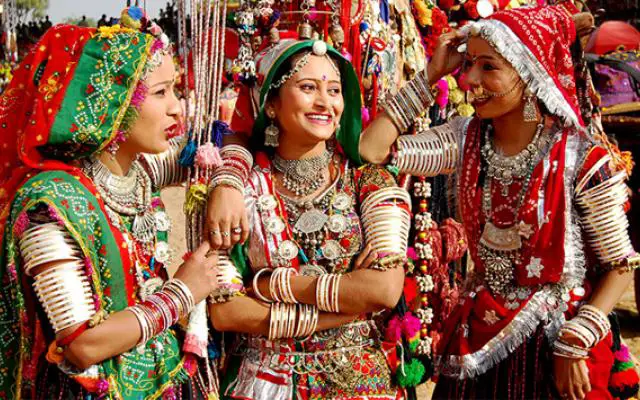Gavri Dance – Mewar’s Tribal Folk Dance
Gavri is a performing art. It is performed by the tribal community, Bhils of Southern Rajasthan, especially in Udaipur, Rajsamand, and Chittorgarh districts. It has some religious beliefs. Gavri festival has been existing since the third century. It is a 40-day festival played in September and October after Raksha Bandhan. It is a festival of dance and drama performed by the Bhil community.
History of Gavri Dance
Gavri has religious importance. It has its origin in the story of Lord Shiva and Bhasmasur. The myth is that a demon named Bhasmasur used to worship Lord Shiva. He wanted a wish from him that was to kill anyone while keeping his hand on the person’s head and killing him burning. Getting happy with his worship Lord Shiva granted him the wish. But, Bhasmasur started misusing it. He killed many innocent people. These worried the gods in heaven. Lord Vishnu disguised himself as a beautiful woman- Mohini, a dancer. He went to Bhasmasur. Bhasmasur was fascinated by her beauty and started imitating her dance. As soon as he kept his hand on his head to copy Mohini, he was killed.
The soul of the demon asked for forgiveness from Lord Shiva. The Lord forgave him. Bhasmasur returned to his devoted life. He wanted to stay alive in the minds of the people. Since then, the festival of Gavri is celebrated in his remembrance in return for his devotion. In this festival, the Bhil community pays homage to the demon Bhasmasur and celebrates every year with great pomp and show.
This drama is played differently. Any open platform is taken as a stage to play the drama in the village. There are five main characters-animals, gods, goddesses, demons, and humans.
- Raiee Budia (represents Lord Shiva and Bhasmasur)
- Mohini and Goddess Parvati
- Kutkadiya or ‘Sutradhar'( narrator) and Pat Bhopa
- Khelye (other players)

The players use many things to attract the audience. They use trident, dhol, thali, and mandal for music. Beautiful costumes, jewelleries, and the settings of the stage and actors produce the efficacy of the play. They adorn the faces of the artists with bright colors, mainly black, yellow, and red. For demons, they use dark blue color and black color for thieves, red color for goddesses, and yellow color for Jogi sadhus.
This drama is played in an ancient ritual, not just an act and dance. It is to seek blessings from Lord Shiva and Goddess Parvati. They pray for an obstruct less life free from misery and pain for a good crop and happy life. This faith and devotion are presented in the form of songs and dances that are easily depicted by the people in the Gavri festival.
Concern for Women
Women are not allowed to participate due to their menstrual cycles. So, men play the role of women by disguising themselves.
Places for Shows
Especially the gavri performers go to the villages where their daughters and sisters reside after getting married. This strengthens their relationship and instills a sense of pride in them.
Condition of Gavri in the Bhil Community
The bhills are poor people. They are dependent on farming and small-scale work. To play gavri is not an easy task for them. They have to spend a huge amount that is beyond their means. There are many villages of bhills where the celebration has not been done for years.
When the Bhil community members are engaged in the Gawri play, they stop farming. When the festival gets over, they start using the new crop. For 30 days, the participants live life in austerity. They follow strict rules like celibacy, barefoot, and non-consumption of meat and alcohol. They had to skip dinner and sleep on the floor. They cannot take baths during this period. These all show that the life of the gavri performers is not easy.
At most, the food and other expenses are borne by the residents of the hosting villages. The gavri group receives donations from the audiences and many groups.
Conclusion
We see Gavri as a unique art that expresses love for the values of lives, and relationships through its exclusive performance. It also shows the conservation of forests and animals and respect for women. It enlightens the audience, especially foreign tourists.
Indian tourism department took a mission to uplift this art to greater heights by taking different steps to organize Gavri shows at many tourist spots and public places.






